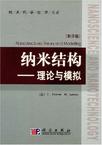纳米结构
2008-6
科学出版社
狄奈许
304
This book is an introduction to the theory of nanostructures.Its main ob-iectives are twof01d:to provide basic concepts for the physics of nano-objectsand to review theoretical methods allowing the predictive simulation of nano-devices.It covers many important features of nanostructures:electronic struc-ture,dielectric properties,optical transitions and electronic transport.Eachtopic is accompanied by a review of important experimental results iu thisfield.we have tried to make the book accessible to inexperienced readersand it only requires basic knowledge in quantum mechanics and in solid statephysics.Whenever possible.each concept is introduced on the basis of simplemodels giving rise to analytical results.But we also provide the reader withthe more elaborate theoretical tools required for simulations OD computers.Therefore.this book is intended not only for the students beginning iu thisfield but also for more experienced researchers.The context of the book is the rapid expansion of nano-technologies re-sulting from important research efforts in a wide range of disciplines such asphysics,biology and chemistry.If much work is presently focusing on the elab-oration.the manipulation and the study of individual nano-objects,a majorchallenge for nano.science is to assemble these objects to make new materialsand new devices,opening the door to new technologies.In this context,as thesystems become more and more complex,and because probing the matter atthe nanoscale remains a challenge,theory and simulation play an essentialrole in the development of these technologies。A large number of simulationtools are already available in science and technology but most of them arenot adapted to the nano-world because,at this scale,quantum mechanicaldescriptions are usually necessary,and atomistic approaches become increas-ingly important.Thus.one main objective of the book is to review recentprogress in this domain.We show that ab initio approaches provide accuratemethods to study small systems(=100-1000).
纳米科学的进展正在越来越依赖计算与模拟。这取决于三个因素的结合:减小纳米物质的尺寸、增强计算机的能力、发展新的理论。本书主要介绍了纳米结构体系中电子结构、介电性质、光学转换、电学输运的基本物理概念、理论方法、重要实验结果及其理论分析与模拟计算,是一本较为系统的、有使用价值的理论专著。 本书对从事纳米科技多学科交叉领域的高年级本科生、研究生及相关的科研教学人员具有重要的参考价值。
作者:(法国)狄奈许(Delerue.C.)
1 General Basis for Computations and Theoretical Models 1.1 Ab initio One-Particle Theories for the Ground State 1.1.1 Non-interacting N Electron System 1.1.2 The Hartree Approximation 1.1.3 The Hartree-Fock Approximation 1.1.4 Correlations and Exchange-Correlation Hole 1.1.5 Local Density Approaches 1.2 Quasi-particles and Excitons 1.2.1 One-Particle Eigenvalues 1.2.2 The Exchange-Correlation Hole and Static Screening 1.2.3 Dynamically Screened Interactions 1.2.4 The GW Approximation 1.2.5 Excitons 1.2.6 Towards a More Quantitative Theory 1.2.7 Time-Dependent Density Functional Theory (TDDFT) 1.3 Semi-empirical Methods 1.3.1 The Empirical Tight Binding Method 1.3.2 The Empirical Pseudopotential Method 1.3.3 The k.p Description and Effective Masses2 Quantum Confined Systems 2.1 Quantum Confinement and Its Consequences 2.1.1 Idealized Quantum Wells 2.1.2 Idealized Quantum Wires 2.1.3 Idealized Cubic Quantum Dots 2.1.4 Artificial Atoms: Case of Spherical Wells 2.1.5 Electronic Structure from Bulk to Quantum Dots 2.2 Computational Techniques 2.2.1 k - p Method and Envelope Function Approximation 2.2.2 Tight Binding and Empirical Pseudopotential Methods 2.2.3 Density Functional Theory 2.3 Comparison Between Different Methods 2.4 Energy Gap of Semiconductor Nanocrystals 2.5 Confined States in Semiconductor Nanocrystals 2.5.1 Electron States in Direct Gap Semiconductors 2.5.2 Electron States in Indirect Gap Semiconductors 2.5.3 Hole States 2.6 Confinement in Disordered and Amorphous Systems3 Dielectric Properties 3.1 Macroscopic Approach: The Classical Electrostatic Theory 3.1.1 Bases of the Macroscopic Electrostatic Theory of Dielectrics 3.3.4 From Microscopic to Macroscopic Dielectric Function for the Bulk Crystal 3.4 Concept of Dielectric Constant for Nanostructures 3.4.1 The Importance of Surface Polarization Charges 3.4.2 Dielectric Screening in Quantum Wells 3.4.3 Dielectric Screening in Quantum Dots 3.4.4 General Arguments on the Dielectric Response in Nanostructures 3.4.5 Conclusions 3.5 Charging of a Nanostructure 3.5.1 Case of a Quantum Dot 3.5.2 Case of a Quantum Well4 Quasi-particles and Excitons 4.1 Basic Considerations 4.2 Excitons in the Envelope Function Approximation 4.2.1 Theory of Bulk Excitons 4.2.2 Excitons in Quantum Wells 4.2.3 Exciton Binding Energy in Limiting Situations 4.2.4 The Influence of Dielectric Mismatch 4.3 Excitons in More Refined Semi-empirical Approaches 4.3.1 General Discussion 4.3.2 Excitons in Nanocrystals of Direct Gap Semiconductors 4.3.3 Excitons in Si Nanocrystals 4.3.4 Screening of the Electron-Hole Interaction and Configuration Interaction 4.4 Quantitative Treatment of Quasi-particles 4.4.1 General Arguments 4.4.2 Tight Binding GW Calculations 4.4.3 Conclusions 4.5 Quantitative Treatment of Excitons 4.5.1 Numerical Calculations 4.5.2 Interpretation of the Results 4.5.3 Comparison with Experiments 4.6 Charging Effects and Multi-excitons 4.6.1 Charging Effects: Single Particle Tunneling Through Semiconductor Quantum Dots 4.6.2 Multi-excitons 4.7 Conclusion5 Optical Properties and Radiative Processes 5.1 General Formulation 5.1.1 Optical Absorption and Stimulated Emission 5.1.2 Luminescence 5.1.3 Nanostructures in Optical Cavities and Photonic Crystals 5.1.4 Calculation of the Optical 5.3.1 Interband Transitions 5.3.2 Intraband Transitions 5.3.3 The Importance of Electron-Phonon Coupling 5.4 Optical Properties of Si and Ge Nanocrystals 5.4.1 Interband Transitions 5.4.2 Intraband Transitions6 Defects and Impurities 6.1 Hydrogenic Donors 6.1.1 Envelope Function Approximation 6.1.2 Tight Binding Self-Consistent Treatment 6.2 Deep Level Defects in Nanostructures 6.3 Surface Defects: Si Dangling Bonds 6.3.1 Review of the Properties of Si Dangling Bonds 6.3.2 Si Dangling Bonds at the Surface of Crystallites 6.3.3 Dangling Bond Defects in III-V and II-VI Semiconductor Nanocrystals 6.4 Surface Defects: Self-Trapped Excitons 6.5 Oxygen Related Defects at Si-SiO2 Interfaces7 Non-radiative and Relaxation Processes 7.1 Multi-phonon Capture at Point Defects 7.2 Auger Recombination 7.2.1 Theoretical Calculation 7.2.2 Experimental Evidence for Auger Recombination 7.3 Hot Carrier Relaxation: Existence of a Phonon Bottleneck8 Transport 8.1 Description of the Systems and of the Boundary Conditions 8.2 Weak Coupling Limit 8.2.1 Perturbation Theory 8.2.2 Orthodox Theory of Tunneling 8.3 Beyond Perturbation Theory 8.3.1 Elastic Scattering Formalism 8.3.2 Calculation of the Green's Functions 8.4 Electron-Electron Interactions Beyond the Orthodox Theory. 8.4.1 Self-Consistent Mean-Field Calculations 8.4.2 The Self-Consistent Potential Profile 8.4.3 The Coulomb Blockade Effect 8.5 Transport in Networks of Nanostructures 8.5.1 Tunneling Between Nanostructures 8.5.2 Hopping Conductivity 8.5.3 Coherent Potential Approximation 8.5.4 Example of a Network of Silicon NanocrystalsA Matrix Elements of the Renormalizing
插图:
《纳米结构:理论与模拟(影印版)》由科学出版社出版。

一本适合理论模拟人员深入研读的好书
理论深了一些
好书,我要好好读,才能领会精神
尽管,纳米理论这个方向做的人很多,但这样专门讲这个方向的书,还很少,本书就是不错的一本。
个人觉得书要写得要专而深又要self-contained,太难了,这种先讲理论再讲应用不失为一种好的策略。 本书值得一看,但是价格有点高啊。
涉及的理论非常全面,相当于一个超长篇review
有需要的地方可以参考 适合背景学习。
这样经典的书不好找呢
在国外也是经典之作!